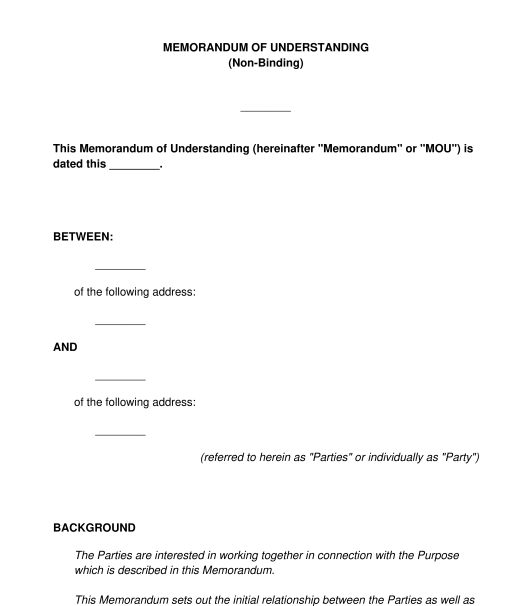 21/09/2025
21/09/2025

Answer a few questions and your document is created automatically.

Your document is ready! You will receive it in Word and PDF formats. You will be able to modify it.




Rating: 4.6 - 56 votes
Fill out the templateA Memorandum of Understanding or MOU is for use between two or more parties that are interested in working together on a particular project. It is intended as a starting point for the parties, as it enables them to set out the preliminary understanding between one another, and can help them to work towards a more formal agreement.
An MOU is intended to be the first step for parties. They may sign the MOU, and then go and work on a formal contract that sets out the terms of their agreement in more detail.
An MOU is designed to not be legally binding, meaning that the parties may not actually be legally obliged to comply with it. This is because in many cases, parties may not actually be certain about the specific terms which they can agree to, but they still find it beneficial to put something in writing, outlining some broader goals (such as the general nature of the project), and confirming that they will act in good faith in pursuit of those goals. Often, parties may sign an MOU outlining some general agreement, and then will go away and make some further investigations before working out the finer details. Although a Party may not be legally bound by this MOU, many parties feel compelled to comply with it anyway - firstly, because the MOU does actually describe what they intend to do, and secondly because they are wary that a failure to comply can harm their professional reputation and their ongoing relationships.
On the other hand, a formal contract is usually intended to be legally binding, so there can be penalties if one of the parties does not comply with it.
No, the parties can go straight ahead and prepare a formal contract if they prefer. However, many parties find it useful to prepare an MOU first. For example, they might prepare an MOU and then give it to their lawyer, so that their lawyer can use the information to prepare a formal contract.
Parties that are involved in complex negotiations where there are a lot of moving parts (for example, in relation to a business sale) often find an MOU particularly helpful.
Usually, the parties that are intending to sign a formal contract will also be the ones who sign the MOU. However, in some cases it might be a related Party. For example, in the case of a business sale, the proposed buyer and seller of the business might sign the MOU. But then before the final contract is prepared, the buyer might go and create a new company which will be the Party that actually signs the formal business sale contract once it is ready.
Once the MOU is ready, it should be signed by both parties and dated. Both parties should keep a copy for their own records. If a formal contract is being prepared subsequently, then the MOU can be provided to whoever is preparing the formal contract.
The Memorandum may then be used as a point of reference to guide the negotiations as the parties move forward towards a final agreement. If a legally binding contract is required, consider some of our other available templates, including:
There are no documents that absolutely must be attached to an MOU. However, depending on what the parties are proposing to do together, there are a number of documents that could be attached. For example:
Usually, an MOU is not legally binding. However, as with any legal matter, this can vary depending on the circumstances. In some cases, MOUs have been found to be legally binding. We cannot confirm whether or not your MOU is legally binding. If you need to be sure about this, then you should seek legal advice.
There are various factors which will help to clarify whether or not an MOU is legally binding, such as:
An MOU should contain:
As the Memorandum is not legally binding, there is no law that directly applies to it.
However, ordinary principles of contract law, as provided by the common law, may be applied in interpreting and understanding the agreement between the parties.
In the event that a Party acts in bad faith, causing another Party to suffer loss, then general principles of equity, estoppel, or laws dealing with misleading and deceptive conduct may become relevant.
You fill out a form. The document is created before your eyes as you respond to the questions.
At the end, you receive it in Word and PDF formats. You can modify it and reuse it.
Guides to help you
Memorandum of Understanding - sample template
Country: Australia